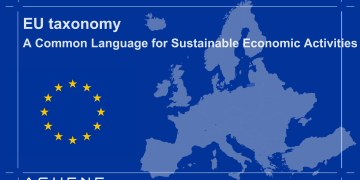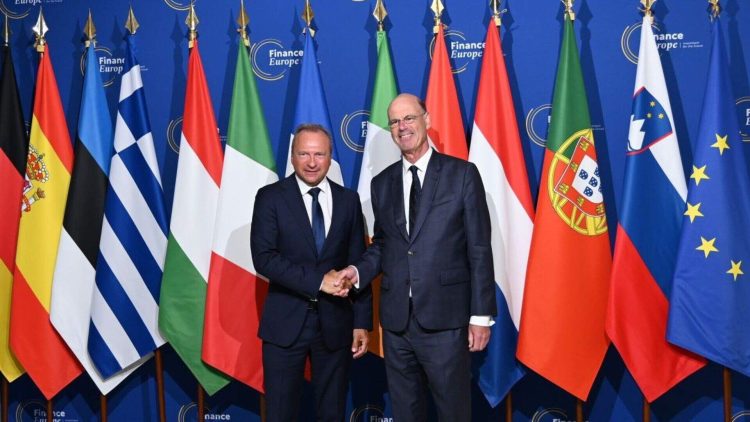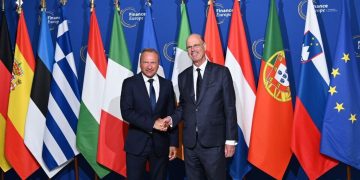Introduction
In 2025, the European Central Bank (ECB) embarked on a decisive monetary easing cycle, marking a clear shift from the restrictive policies that dominated the post-pandemic period. While the United States maintains relatively higher interest rates to curb persistent inflation, the ECB has cut rates multiple times and signaled a readiness to expand liquidity, supporting an economy challenged by weak growth, fragmented fiscal policies, and structural labor-market issues.
This new phase of monetary policy represents a fundamental recalibration: from inflation containment to growth support. It carries profound implications for European financial markets, capital flows, corporate investment, and the broader global economy. The combination of rate cuts and ongoing balance-sheet reduction presents a delicate balancing act, where easing must stimulate growth without igniting financial instability or undermining the euro’s credibility.
This article explores the drivers, mechanics, and consequences of the ECB’s monetary easing, examining how policy affects capital markets, corporate finance, the euro, and European economic risk.
I. The Context for ECB Easing
1. Weak Economic Growth
The Eurozone economy has struggled to regain momentum post-pandemic:
- Germany faces stagnation in manufacturing and exports
- Southern Europe (Italy, Spain, Greece) grapples with structural debt constraints
- Consumer demand remains muted despite modest wage growth
GDP growth projections for 2025 hover around 0.8–1.2%, highlighting a stark contrast with the United States.
2. Inflation Dynamics
Unlike the U.S., inflation in Europe has become more muted and energy-driven:
- energy price stabilization has reduced headline inflation
- core inflation remains below the ECB’s target in several member states
- wage growth is moderate and uneven across regions
This weakens the case for restrictive monetary policy and strengthens the rationale for easing.
3. Fragmented Fiscal Policies
European fiscal policy is uneven:
- Northern states maintain fiscal discipline
- Southern economies struggle with high debt
- EU-wide coordination is limited
Monetary easing is intended to offset these fiscal disparities and prevent a credit crunch in weaker economies.
II. ECB Policy Actions in 2025
1. Interest Rate Cuts
In 2025, the ECB cut its main refinancing rate multiple times, lowering borrowing costs across the Eurozone:
- Main refinancing rate decreased to historically low levels
- Deposit facility rates moved deeper into negative territory
The goal: stimulate lending, encourage investment, and counteract stagnating growth.
2. Balance-Sheet Reduction vs. Expansion
While rate cuts signal monetary easing, the ECB’s approach to its balance sheet is more nuanced:
- Ongoing reduction of pandemic-era bond holdings continues
- Limited reinvestments signal fiscal prudence and inflation credibility
- New liquidity programs are selectively deployed to support weak sovereign markets
The ECB is attempting to achieve easing without undermining its long-term credibility—a delicate balancing act.
3. Forward Guidance and Communication
The ECB has emphasized:
- continued policy flexibility
- conditionality based on economic data
- commitment to financial stability
Clear guidance aims to prevent market overreaction while reinforcing confidence in European monetary stability.
III. Impact on Capital Markets
1. Sovereign Bond Markets
Rate cuts reduce short-term yields but create complex dynamics:
- Long-term yields remain sensitive to inflation expectations and fiscal risk
- Yield curves exhibit bull-steepening tendencies in peripheral countries
- Investors weigh liquidity, risk, and potential capital gains from European bonds
Markets adjust rapidly to ECB signals, leading to temporary volatility and repricing opportunities.
2. Corporate Credit
Easing reduces borrowing costs:
- Euro-denominated corporate bonds become more attractive
- Companies benefit from lower financing costs for investment and refinancing
- High-yield sectors see spreads narrow, stimulating risk appetite
However, persistent growth weakness limits credit expansion, creating uneven impacts across sectors.
3. Equity Markets
Rate cuts generally boost equity valuations:
- Lower interest rates reduce discount rates for future earnings
- Banks face narrower net interest margins, but corporate sectors benefit from cheaper credit
- Defensive sectors may outperform cyclical industries due to underlying growth fragility
IV. Euro Currency Dynamics
Despite monetary easing, the euro has experienced unexpected strength relative to the dollar. Several factors explain this paradox:
- Weakening U.S. dollar during periods of market risk-off or anticipation of Fed cuts
- Trade surplus in the Eurozone supports demand for euros
- Safe-haven flows into European government bonds during global uncertainty
This euro strength has mixed implications:
- It dampens export competitiveness, particularly for Germany
- Reduces import costs for energy and intermediate goods
- Alters corporate profit margins and investment incentives
ECB policymakers must navigate the tension between domestic easing and external currency pressures.

V. Banking and Financial Stability Considerations
1. Impact on Eurozone Banks
Low and negative interest rates challenge bank profitability:
- Net interest margins are compressed
- Deposit-heavy banks face reduced revenue
- Risk-taking may increase as banks seek higher yields
2. Liquidity and Credit Provision
Easing supports credit flow but requires careful monitoring:
- Banks may preferentially lend to larger, safer borrowers
- Small and medium enterprises (SMEs) may still face financing constraints
- Central bank liquidity facilities are essential to prevent a credit freeze
3. Systemic Risk
Easing must avoid creating asset bubbles:
- Low rates encourage risk-taking in real estate and equities
- Market distortions can emerge if credit growth exceeds economic fundamentals
- ECB must balance growth support against financial stability
VI. Sectoral and Regional Impacts
1. Manufacturing vs. Services
- Manufacturing benefits less from rate cuts due to weak global demand
- Services may see modest stimulation through lower financing costs and consumer borrowing
2. Regional Disparities
- Northern Europe may see smaller impact due to robust fiscal frameworks
- Southern Europe benefits more, but structural weaknesses limit long-term gains
VII. Global Implications
1. Capital Flows
- Lower euro rates may push global investors toward U.S. assets
- Cross-border investment patterns adjust, affecting yields and liquidity in multiple regions
2. European Competitiveness
- Monetary easing can offset weak fiscal policy, maintaining investment appeal
- Currency strength may partially undermine competitiveness
3. Spillover to Emerging Markets
- Easing may reduce European financial pressure on EM borrowers
- But a strong dollar and higher U.S. yields can still create tension in capital markets
VIII. Risks and Challenges
1. Policy Timing
Premature cuts may overstimulate some economies while failing to address structural growth limitations.
2. Inflation Surprises
Energy or geopolitical shocks could reverse the inflation trend, forcing abrupt policy reversals.
3. Market Overreliance
Investors may misprice risk, assuming continuous ECB support.
4. Structural Constraints
- Labor market rigidities
- Demographic challenges
- Fragmented fiscal policies
limit the effectiveness of monetary easing alone.
IX. Strategic Outlook
The ECB’s 2025 monetary easing strategy suggests:
- Short-term rate cuts will provide liquidity and modest growth support
- Balance-sheet management will remain cautious to avoid credibility loss
- Eurozone banks and corporates must adapt to prolonged low-rate environment
- Investors must navigate currency volatility and regional disparities
- Global spillovers will shape the transatlantic financial landscape
The ECB’s approach embodies the tension between economic stimulus and financial stability—an ongoing challenge in Europe’s structurally diverse monetary union.
Conclusion
European monetary easing in 2025 marks a significant pivot from restrictive policy to support-focused intervention. Rate cuts and selective liquidity programs aim to stimulate weak growth, sustain credit provision, and stabilize markets. However, structural weaknesses, currency dynamics, and global interconnections mean that easing is neither simple nor risk-free. Investors, policymakers, and corporates must anticipate both opportunities and vulnerabilities as the ECB balances the dual mandate of growth support and financial stability.
Europe’s monetary strategy now stands at a crossroads, defining not only the trajectory of the eurozone economy but also shaping the broader dynamics of transatlantic financial flows in 2025.




































